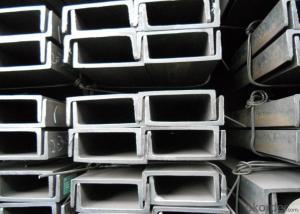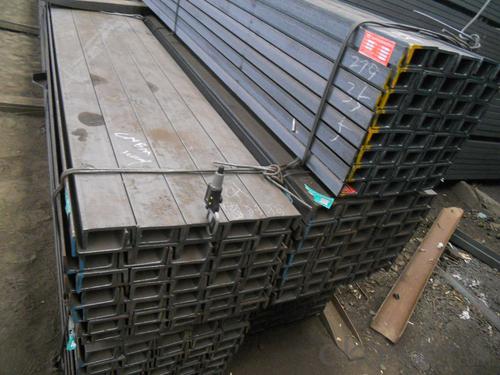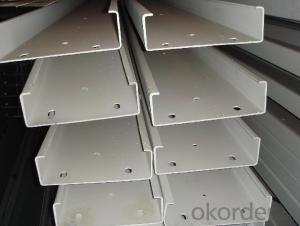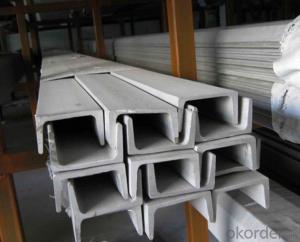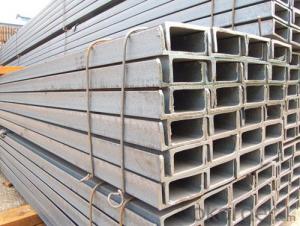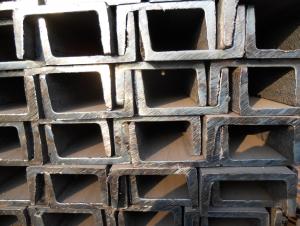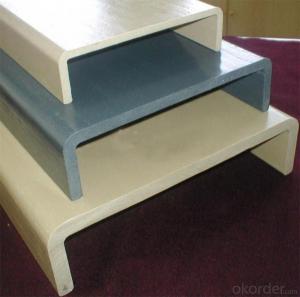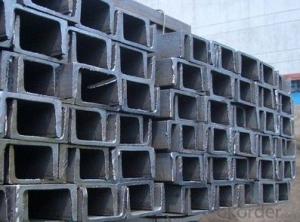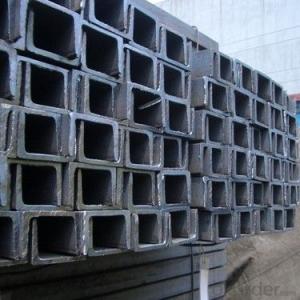JIS G3192 U Channel Steel high quality
- Loading Port:
- Tianjin
- Payment Terms:
- TT OR LC
- Min Order Qty:
- 25 m.t
- Supply Capability:
- 20000 m.t/month
OKorder Service Pledge
OKorder Financial Service
You Might Also Like
Product Description:
OKorder is offeringJIS G3192 U Channel Steel high qualitygreat prices with worldwide shipping. Our supplier is a world-class manufacturer of steel, with our products utilized the world over. OKorder annually supplies products to European, North American and Asian markets. We provide quotations within 24 hours of receiving an inquiry and guarantee competitive prices.
Product Applications:
JIS G3192 U Channel Steel high quality are ideal for structural applications and are widely used in the construction of buildings and bridges, and the manufacturing, petrochemical, and transportation industries.
Product Advantages:
OKorder's JIS G3192 U Channel Steel high qualityare durable, strong, and resist corrosion.
Main Product Features:
· Premium quality
· Prompt delivery & seaworthy packing (30 days after receiving deposit)
· Corrosion resistance
· Can be recycled and reused
· Mill test certification
· Professional Service
· Competitive pricing
Product Specifications:
Specifications of Steel U Channel:
Standard Applied: GB Standard, EN Standard(UPN), JIS Standard
Sizes: 50mm to 300mm
Material Grade: Q235B, Q345B, S235JR, SS400, ASTM A36
As shown in the figure:
JIS U CHANNEL | Standard h | Sectional b | Dimension s | t | Mass: Kg/m |
(mm) | (mm) | (mm) | (mm) | ||
50x25 | 50 | 25 | 3.0 | 6.00 | 2.37 |
75X40 | 75 | 40 | 3.8 | 7.00 | 5.30 |
75X40 | 75 | 40 | 4.0 | 7.00 | 5.60 |
75X40 | 75 | 40 | 4.5 | 7.00 | 5.85 |
75X40 | 75 | 40 | 5.0 | 7.00 | 6.92 |
100X50 | 100 | 50 | 3.8 | 6.00 | 7.30 |
100X50 | 100 | 50 | 4.2 | 6.00 | 8.03 |
100X50 | 100 | 50 | 4.5 | 7.50 | 8.97 |
100X50 | 100 | 50 | 5.0 | 7.50 | 9.36 |
125X65 | 125 | 65 | 5.2 | 6.80 | 11.66 |
125X65 | 125 | 65 | 5.3 | 6.80 | 12.17 |
125X65 | 125 | 65 | 5.5 | 8.00 | 12.91 |
125X65 | 125 | 65 | 6.0 | 8.00 | 13.40 |
150x75 | 150 | 75 | 5.5 | 7.30 | 14.66 |
150x75 | 150 | 75 | 5.7 | 10.00 | 16.71 |
150x75 | 150 | 75 | 6.0 | 10.00 | 17.90 |
150x75 | 150 | 75 | 6.5 | 10.00 | 18.60 |
Note: We are able to supply other dimensions and sizes, which depends on the customer's requirements for the quantity.
Chemical Composition of Q235B Steel U Channel:
Alloy No | Grade | Element(%) | ||||
C | Mn | S | P | Si | ||
Q235 | B | 0.12-0.20 | 0.3-0.7 | ≦0.045 | ≦0.045 | ≦0.3 |
Package & Delivery of JIS U Channel Steel:
1.The JIS u channel steel will be packed in bundle with steel wire at each end of every bundle and color marking in order to help the customer to recognize his goods more easily at sight.
2. And the channel steel could be loaded into 20ft or 40ft container, or by bulk cargo.If the weight of each bundle reaches more than 3.5 mt, the loading by break bulk cargo should be choosed.When the weight of each bundle reaches less than 3mt, the loading by container should be choosed.
3.As for the transportaion from mill to loading port, the truck will be usually used. And the maximum quantity for each truck is 40mt.
4.All in all, we could do in accordance with customer's request.
FAQ:
Q1: Why buy Materials & Equipment from OKorder.com?
A1: All products offered byOKorder.com are carefully selected from China's most reliable manufacturing enterprises. Through its ISO certifications, OKorder.com adheres to the highest standards and a commitment to supply chain safety and customer satisfaction.
Q2: Can fit in the containers of 20fts the steel beams of 6M?
A2: No proble, we can put them into the containers in the form sideling.
Q3: The products are invoicing on theoritical weight or on actual weight?
A3: We can do it in both manners, according to the customers' request.
Images:


- Q: What are the methods and the price of building the floor?
- Your house must have enough floor height. In general, the lower floor of the new attic in the duplex room is flat with the lower edge of the original floor. A single mezzanine floor with a lower margin of not less than 2.6 meters. In the attic floor and the roof height of not less than 2.4 meters, a minimum of not less than 2.2 meters. This is based on the premise that people are living. If your attic is not available, then you can make your own discretion.
- Q: Can steel channels be used for supporting rooftop solar arrays?
- Yes, steel channels can be used for supporting rooftop solar arrays. Steel channels provide strength, durability, and stability, making them suitable for bearing the weight of solar panels and withstanding various environmental conditions. Additionally, steel channels can be easily installed and adjusted to accommodate the specific requirements and layout of a rooftop solar array.
- Q: How do steel channels contribute to sound insulation?
- Steel channels can contribute to sound insulation by providing a rigid structure that helps to minimize the transmission of sound waves. When steel channels are used in the construction of walls or ceilings, they create a framework that can be filled with sound-absorbing materials such as insulation or acoustic panels. This combination of the steel channels and sound-absorbing materials helps to dampen and absorb sound energy, reducing the amount of noise that can pass through the structure. Additionally, steel channels can also be used to create double or staggered wall systems, which further enhances sound insulation by creating air gaps that act as barriers to sound transmission. Overall, steel channels play a crucial role in sound insulation by providing a solid foundation and structure for sound-absorbing materials and creating a barrier that prevents sound from traveling through the building.
- Q: Can steel channels be used for mezzanine storage systems?
- Indeed, mezzanine storage systems can utilize steel channels. Owing to their robustness and longevity, steel channels are frequently employed in the construction of mezzanine floors. They offer a solid and secure foundation for bearing the load of storage items and seamlessly integrate into the overall design of the mezzanine structure. Steel channels can be tailored to meet specific needs and assembled through welding or bolting to establish a sturdy storage system. Moreover, steel channels boast corrosion resistance, rendering them suitable for enduring use in both indoor and outdoor storage settings.
- Q: Can steel channels be used in stadium construction?
- Yes, steel channels can be used in stadium construction.
- Q: What are the common design codes and standards for steel channels?
- There are several common design codes and standards for steel channels that ensure their structural integrity and safety. The most widely recognized codes and standards for steel channel design are: 1. American Institute of Steel Construction (AISC): AISC provides the specification for the design, fabrication, and erection of structural steel for buildings, also known as the AISC Steel Construction Manual. This manual outlines guidelines for the design of steel channels, including their dimensions, loading conditions, and connection requirements. 2. American Society of Civil Engineers (ASCE): ASCE produces standards and guidelines for various civil engineering structures, including steel channels. Their publication, ASCE 7-16 Minimum Design Loads and Associated Criteria for Buildings and Other Structures, provides specifications for determining the loads and load combinations that steel channels must be designed to withstand. 3. International Building Code (IBC): The IBC is a comprehensive set of building regulations adopted by many countries globally. It includes provisions for the design of steel channels and other structural elements, focusing on safety, load resistance, and structural stability. 4. European Committee for Standardization (EN): The EN standards provide specifications for various steel products, including channels. EN 10025-2 is specifically applicable to hot-rolled structural steel channels and outlines their mechanical properties, dimensions, and tolerances. 5. British Standards Institution (BSI): BSI publishes standards for steel channels under the BS EN 10365 series. These standards cover the dimensions, tolerances, and technical requirements for hot-rolled steel channels used in construction. It is important for designers, engineers, and manufacturers to adhere to these codes and standards to ensure the proper design, fabrication, and safe usage of steel channels in various structural applications. Compliance with these guidelines helps ensure consistency, quality, and structural integrity in the construction industry.
- Q: Are steel channels suitable for the mining parts manufacturing industry?
- Yes, steel channels are suitable for the mining parts manufacturing industry. Steel channels are commonly used in various industries, including mining, due to their strength, durability, and versatility. They provide structural support and stability, making them ideal for manufacturing mining parts that require a robust and reliable material. The mining industry often deals with heavy-duty equipment, machinery, and components that must withstand harsh conditions and extreme forces. Steel channels offer excellent load-bearing capacity and resistance to impact, making them well-suited for manufacturing parts such as support beams, frames, and brackets used in mining equipment. Moreover, steel channels can be fabricated to meet specific dimensional requirements, allowing manufacturers to create custom-designed parts tailored to the unique needs of the mining industry. They can be easily cut, welded, and shaped into complex forms, enabling the production of intricate mining components. Additionally, steel channels are known for their corrosion resistance, which is crucial in mining environments that often involve exposure to moisture, chemicals, and abrasive materials. This resistance to corrosion helps extend the lifespan of mining parts and reduces the need for frequent replacements or repairs, ultimately improving operational efficiency and reducing costs. Furthermore, steel channels are readily available, making them a cost-effective choice for the mining parts manufacturing industry. The widespread use of steel channels also means that there is a vast amount of expertise and knowledge in working with this material, allowing for efficient production processes and reliable quality control. In conclusion, steel channels are highly suitable for the mining parts manufacturing industry due to their strength, durability, versatility, corrosion resistance, and cost-effectiveness. These qualities make steel channels an ideal choice for producing mining parts that can withstand the demanding conditions and requirements of the mining industry.
- Q: Can steel channels be used in the construction of solar panel mounting structures?
- Yes, steel channels can be used in the construction of solar panel mounting structures. Steel channels provide strong support and stability, making them suitable for holding the weight of solar panels and withstanding various environmental conditions.
- Q: Can steel channels be used in railway infrastructure projects?
- Yes, steel channels can be used in railway infrastructure projects. Steel channels are commonly used in the construction and maintenance of railway tracks, bridges, and other structures. They provide strength, stability, and durability, making them suitable for supporting heavy loads and withstanding the constant movement and vibrations associated with railway operations. Steel channels can be used for various applications in railway infrastructure, such as supporting the rails, constructing track sleepers, reinforcing bridges and tunnels, and creating barriers and fencing for safety purposes. Additionally, steel channels can be customized to meet specific project requirements in terms of size, shape, and material composition, further enhancing their suitability for railway infrastructure projects.
Send your message to us
JIS G3192 U Channel Steel high quality
- Loading Port:
- Tianjin
- Payment Terms:
- TT OR LC
- Min Order Qty:
- 25 m.t
- Supply Capability:
- 20000 m.t/month
OKorder Service Pledge
OKorder Financial Service
Similar products
Hot products
Hot Searches
Related keywords

